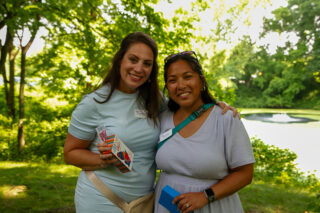Posted in Garden News on September 24, 2024, by Caryn Hummell
Caryn Hummell is the Urban Advantage Coordinator at the New York Botanical Garden.

In July, the New York Botanical Garden’s Teacher Professional Learning team partnered with the Children’s Environmental Literacy Foundation (CELF) to offer a free three-day Civic Science Summer Institute: Narrating Our Place in Nature. The workshop equipped 28 teachers from NYC and Westchester County with the knowledge and resources to apply CELF’s Inquiry-to-Action Framework to their 2024-25 curriculum. “It is essential for students to connect with nature in order to foster and protect it,” emphasized a teacher participant.
Over three days, we dissected the Inquiry-to-Action framework and explored storytelling as a means to pass down knowledge, values and environmental care. CELF facilitators, Rowena Capuno, Vicky Garufi LoIacono, and Tara Stafford Ocansey, shed light on their personal stories and career pathways to model how teachers can invite students to bring their whole selves into the classroom. “Kids inherently have a connection with nature, but in today’s society, there are many challenges to nurture this connection, especially if one has limited access to green space. We have to foster the connection, but we also have to model that through our own lives and stories,” shared Rowena.

We connected to the natural world and mapped our place. We examined the intersection of civic science and citizen or community science, a process in which the public voluntarily collects data for scientific research. Guest speaker Brad Oberle, Associate Curator, discussed his community science work studying the carbon production and retention capacity of restored coastal habitats in Florida. In the African American Garden and Family Garden at the Edible Academy, teachers observed Garden educators use exploratory, hands-on experiences to encourage curiosity and connection with nature. Finally, we shared our own eco-narratives and drafted place-based inquiry questions, considering what students may be driven to change in their neighborhoods.
This school year, these teachers and their 3,400 students will connect to their local place, develop an inquiry question about an environmental issue that’s important to them, collect data, analyze patterns, and design a solution. Then, they will take action to present their findings to decision-makers and field experts. “Partnership—from individuals connecting to institutions sharing resources and projects—is the foundation of environmental work,” concluded another.

As a facilitator, it was deeply inspiring to collaborate with a like-minded organization. We are a part of the natural world. When children feel connected to their local place, they’re more likely to care for it. This idea is central to our work with teachers and students at the Garden. The Children’s Environmental Literacy Foundation goes one step further. They give learners the tools to see that everyone has the ability to change or impact a system, community and themselves. With a sense of place and agency, students can become environmental stewards and community activists.
The Children’s Environmental Literacy Foundation’s mission is to establish sustainability as an integral part of every child’s K-12 learning experience. Since 2003, CELF has equipped over 15,000 educators with tools that empower students to connect the Big Ideas of Sustainability to their communities through place-based learning and data-driven discovery, with support from the National Geographic Society.